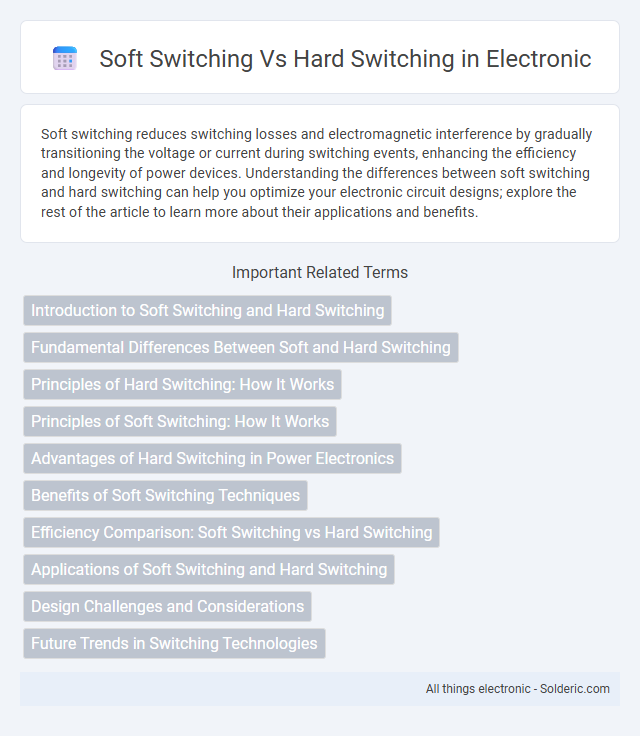Soft switching reduces switching losses and electromagnetic interference by gradually transitioning the voltage or current during switching events, enhancing the efficiency and longevity of power devices. Understanding the differences between soft switching and hard switching can help you optimize your electronic circuit designs; explore the rest of the article to learn more about their applications and benefits.
Comparison Table
| Aspect | Soft Switching | Hard Switching |
|---|---|---|
| Definition | Switching technique minimizing switching losses by turning devices ON/OFF at zero voltage or zero current | Traditional switching where devices turn ON/OFF under non-zero voltage and current |
| Switching Losses | Low switching losses due to reduced overlap of voltage and current | High switching losses caused by simultaneous voltage and current during switching |
| Electromagnetic Interference (EMI) | Significantly reduced EMI generation | Higher EMI due to abrupt voltage/current transitions |
| Switching Frequency | Enables higher switching frequencies | Limited switching frequency to prevent excessive losses |
| Complexity | More complex circuits and control required | Simpler circuit design and control |
| Device Stress | Lower stress on power devices enhancing reliability | Higher electrical and thermal stress on devices |
| Applications | Used in high-efficiency power converters, resonant converters, and soft-switched inverters | Common in standard hard-switched converters and basic switching power supplies |
Introduction to Soft Switching and Hard Switching
Soft switching reduces switching losses and electromagnetic interference by gradually transitioning power devices between on and off states, often utilizing zero-voltage or zero-current switching techniques. Hard switching involves abrupt switching transitions where devices switch directly on or off under voltage and current, leading to higher switching losses and stress on components. The choice between soft and hard switching impacts efficiency, thermal management, and lifespan in power electronics applications.
Fundamental Differences Between Soft and Hard Switching
Soft switching reduces switching losses and electromagnetic interference by transitioning devices during zero voltage or zero current conditions, while hard switching involves switching at full voltage and current, leading to higher stress on components. The fundamental difference lies in how energy is transferred and dissipated during the switching process, impacting efficiency and thermal management. Your choice between soft and hard switching significantly affects power converter performance, system reliability, and electromagnetic compatibility.
Principles of Hard Switching: How It Works
Hard switching operates by abruptly turning semiconductor devices on and off, causing rapid transitions between conduction and non-conduction states. This method results in high switching losses and electromagnetic interference due to voltage and current overlap during transitions. Understanding your converter's performance requires analyzing these instantaneous voltage and current spikes characteristic of hard switching principles.
Principles of Soft Switching: How It Works
Soft switching reduces switching losses in power electronics by minimizing voltage and current overlap during transistor transitions. It leverages techniques like zero-voltage switching (ZVS) and zero-current switching (ZCS) to turn devices on or off when voltage or current is near zero, enhancing efficiency and reducing electromagnetic interference. These principles extend device lifespan and improve system reliability compared to hard switching, which involves abrupt transitions causing significant stress and power dissipation.
Advantages of Hard Switching in Power Electronics
Hard switching in power electronics offers simplicity in circuit design and control, making it easier to implement and troubleshoot. It allows for faster switching speeds, which can enhance power conversion efficiency under certain load conditions. The technology is well-established with widespread availability of compatible components, contributing to cost-effectiveness in numerous industrial applications.
Benefits of Soft Switching Techniques
Soft switching techniques significantly reduce switching losses and electromagnetic interference (EMI) in power electronics, enhancing overall efficiency and reliability. Your power converters benefit from lower thermal stress and extended component lifespan due to reduced voltage and current spikes during transitions. Implementing soft switching can lead to quieter operation and improved system performance in high-frequency applications.
Efficiency Comparison: Soft Switching vs Hard Switching
Soft switching significantly improves efficiency by reducing switching losses through zero voltage or zero current transitions, resulting in lower heat dissipation and higher overall power conversion efficiency compared to hard switching. Hard switching involves abrupt voltage and current changes, causing substantial switching losses and electromagnetic interference, which decrease system efficiency and increase thermal management requirements. Consequently, soft switching is preferred in high-frequency power electronics applications where efficiency and reliability are critical.
Applications of Soft Switching and Hard Switching
Soft switching is predominantly applied in high-efficiency power converters, such as resonant inverters and wireless power transfer systems, where minimizing switching losses and electromagnetic interference (EMI) is critical. Hard switching is commonly used in cost-sensitive applications like basic DC-DC converters and simple motor drives, where design simplicity and lower component count are prioritized over efficiency. Industrial motor controllers, uninterruptible power supplies, and consumer electronics often choose soft switching techniques to enhance reliability and thermal management, while hard switching remains standard in low-frequency or low-power devices due to its straightforward implementation.
Design Challenges and Considerations
Soft switching reduces switching losses and electromagnetic interference, but presents design challenges such as precise timing control and increased circuit complexity. Hard switching is simpler to implement but suffers from higher switching losses and stress on components, leading to thermal management issues. Understanding these trade-offs helps you optimize efficiency and reliability in power electronics designs.
Future Trends in Switching Technologies
Future trends in switching technologies emphasize the growing adoption of soft switching techniques due to their ability to significantly reduce electromagnetic interference (EMI) and switching losses in power converters. Advances in wide bandgap semiconductors like SiC and GaN enhance the efficiency and thermal performance of soft switched devices, enabling higher switching frequencies and improved power density. Integration of digital control algorithms and artificial intelligence further optimizes soft switching operations, positioning it as the preferred choice for next-generation power electronics in renewable energy and electric vehicle applications.
soft switching vs hard switching Infographic

 solderic.com
solderic.com